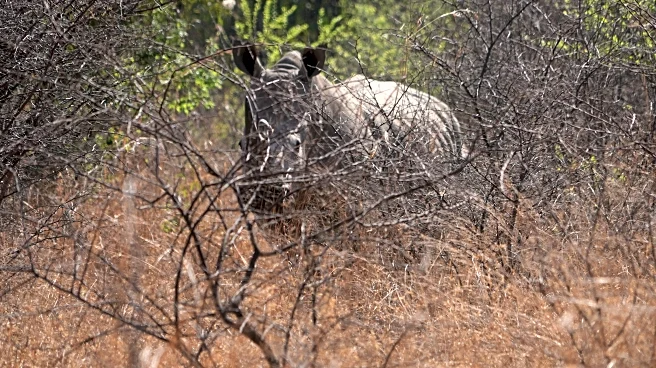What's Happening?
A recent report by TRAFFIC and the International Union for Conservation of Nature (IUCN) highlights the precarious situation of rhinoceros populations worldwide. Despite facing threats from poaching, habitat fragmentation, and climate change, there are signs of recovery in certain regions. Greater one-horned rhinos in India and Nepal have increased to over 4,000 individuals, and black rhino numbers are slowly rising. Efforts such as habitat restoration, community engagement, and dehorning have significantly reduced poaching incidents. Additionally, technological advancements have led to the first successful IVF pregnancy in a rhino, offering hope for future conservation strategies.
Why It's Important?
The rhinoceros is a keystone species, playing a crucial role in maintaining the ecological balance of their habitats. Their recovery is vital not only for biodiversity but also for the communities that coexist with them. The resurgence of rhino populations in Asia and Africa demonstrates the effectiveness of conservation strategies and the importance of international cooperation. The reduction in poaching through dehorning and community involvement highlights the potential for sustainable wildlife management. This progress serves as a model for other endangered species and underscores the need for continued vigilance and support for conservation efforts.
What's Next?
Continued efforts are necessary to ensure the long-term survival of rhinoceros populations. Conservationists are likely to focus on expanding habitat restoration projects and enhancing community-based conservation programs. The success of IVF technology may lead to further research and application in breeding programs. Governments and international organizations may increase funding and support for anti-poaching initiatives and technological innovations. Monitoring and adapting to climate change impacts will also be crucial in safeguarding these species.
Beyond the Headlines
The ethical implications of dehorning and the use of technology in conservation raise important questions about human intervention in wildlife management. Balancing the immediate need to protect rhinos with long-term ecological impacts requires careful consideration. The cultural significance of rhinos in local communities and their role in tourism and economic development add layers to the conservation narrative. As global awareness grows, the rhino's plight may inspire broader environmental action and policy changes.












